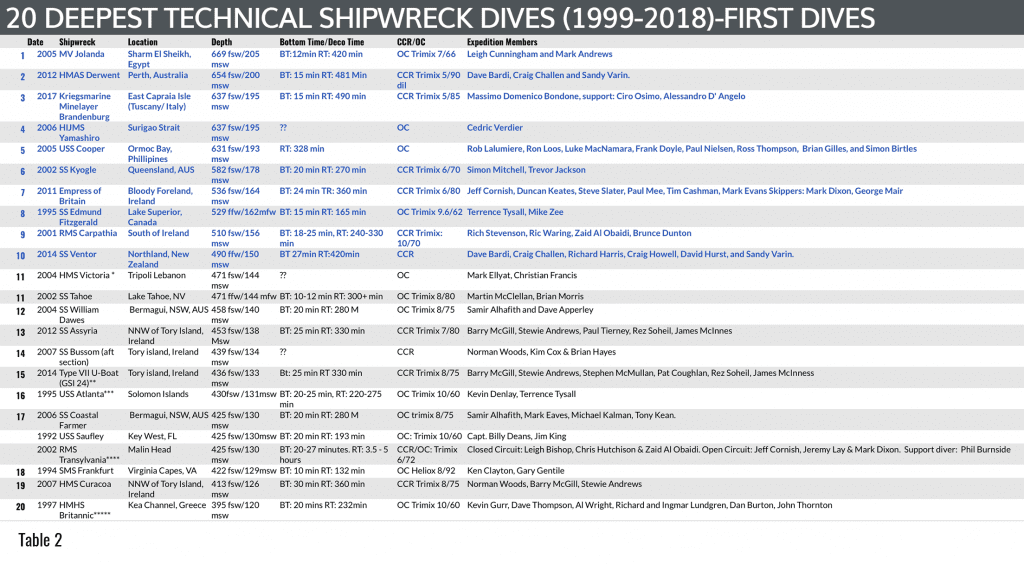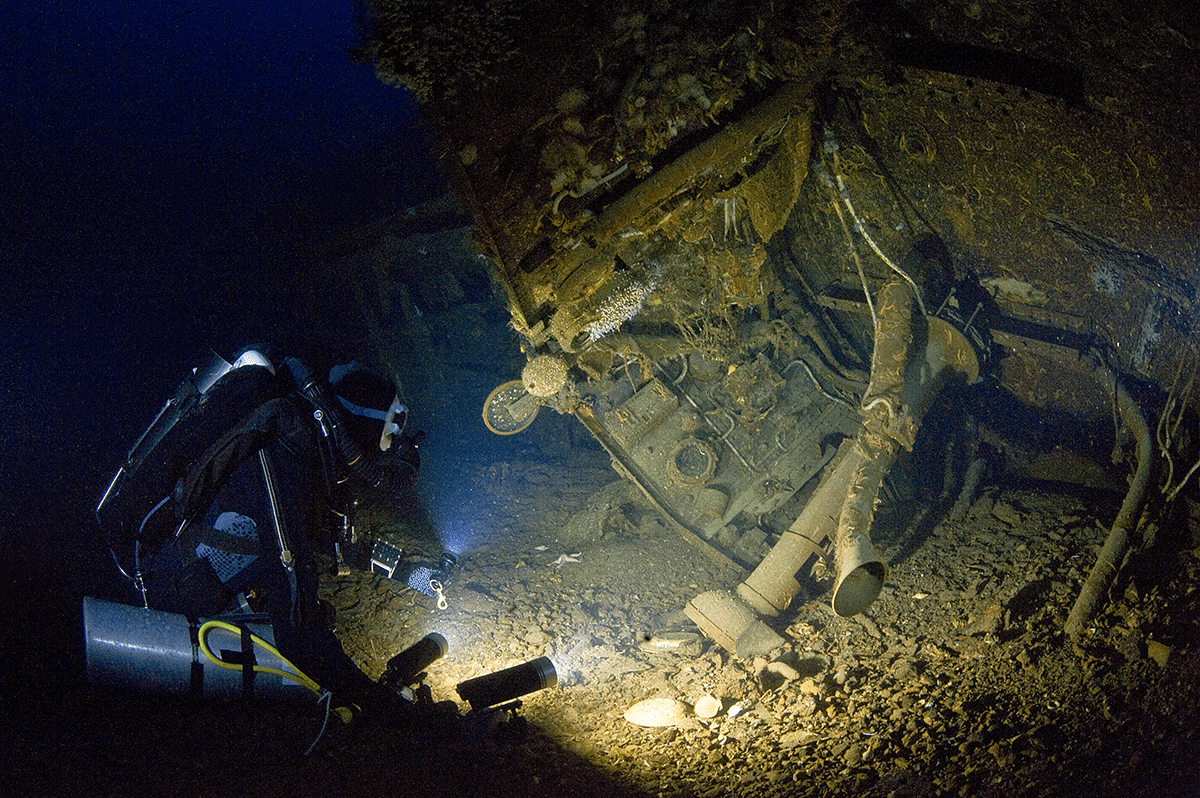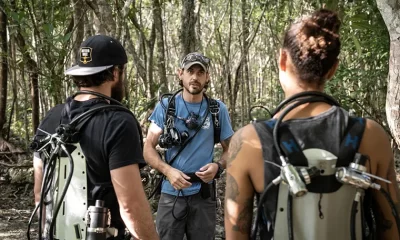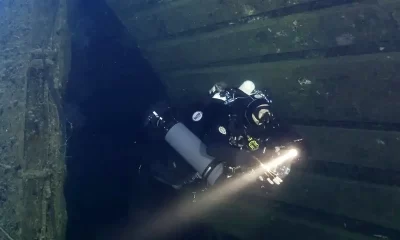Community
How Deep is Deep? The 20 Deepest Tech Shipwreck Dives and How They Compare to Dives in the 1990s
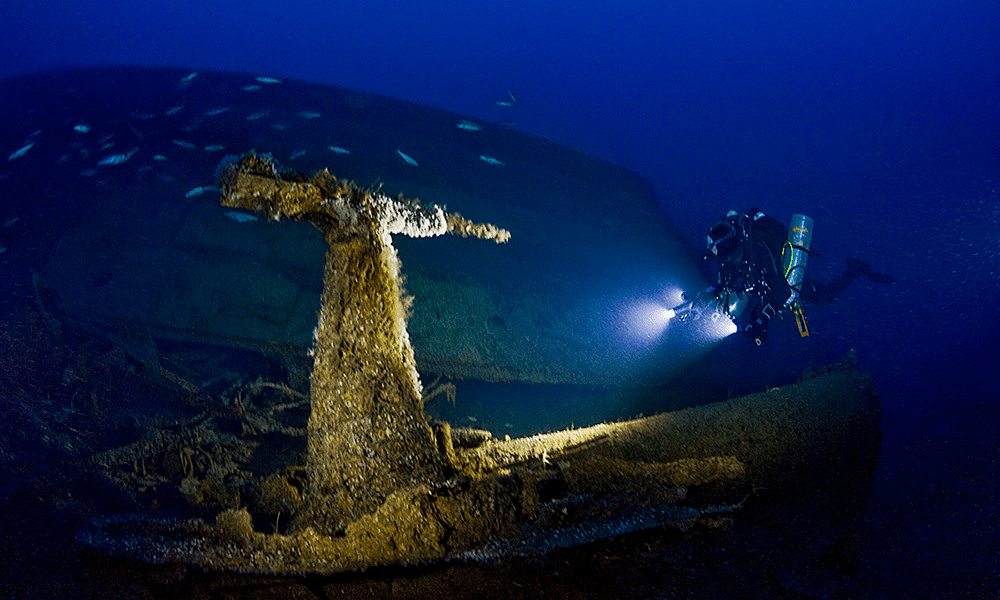
By Michael Menduno
*This article has been updated from this version to the 30 Deepest Shipwrecks and new wrecks have been added after reader feedback.
The advent of mixed gas usage by sport divers—the so-called “Technical Diving Revolution”—in the early to mid-1990s greatly expanded our community’s underwater envelope, while arguably improving diving safety. In order to appreciate how far, err deep, we have collectively come, I thought it would be illustrative to contrast the deepest tech shipwreck dives from today to those in the 1990s when technical diving was just getting started. A similar exercise could be done with cave diving.
Back in the early to mid-90s, technical diving pioneer Capt. Billy Deans, owner of Key West Diver, observed that mix technology enabled us to “double our underwater playground.” Deans was contrasting the then existing recreational diving limits, (i.e., no-stop dives to 130ft/40m) to the new technical diving envelope that was made possible with the use of helium-based bottom gas and accelerated decompression using nitrox and oxygen. Note that during this period, the words “deep” (beyond 40 m) and “decompression”, (i.e., “The D-words,”) were considered four-letter words by many in the recreational diving establishment.
At the time, we considered open water decompression dives with 15-25 minutes of bottom time to depths of 260 ft/79 m to represent a reasonably reliable envelope for technical mixed gas diving operations. That’s what Deans meant about doubling of our recreational playground. Because of the ability to more easily stage bailout and decompression gas in the cave environment, the envelope there was considered deeper/longer. That is not to say that tekkies weren’t diving deeper than 260 ft/79 m and staying longer, but at that time, we considered these dives to be “exceptional exposures”, requiring special methods and work.
Deep Shipwreck Dives in The 1990s
Table 1 below highlights the ten deepest tech wreck dives from 1989-1999, including their location, depth, dive profile, the technology used, and the technical divers who first dived the wreck. The majority of these dives were reported at the time in my magazine aquaCORPS Journal. The deepest dive at the time was the Edmund Fitzgerald at 530 ft/162 m in Lake Superior. The shallowest in the table was the RMS Lusitania at 310 ft/95 m.
Average depth: 398 fsw/122 msw, Avg Bottom Time: 16.7 min Average Run Time: 192 min
* Note that Tysall & Zee’s dive on the Fitz was essentially a “sneak” dive i.e. they did not have permission to dive the wreck, which was a gravesite, though they laid a plaque on the wreck with the names of the fallen.
** Denlay & Tysall’s first dive in 1995 was to 361 fsw/110msw on the shallow stern of the Atlanta. They returned in 1997/98 where they made their deepest dive to the bow.
** Jacque Cousteau, Albert Falco (team leader), Raymond Coll (camera), Ivan Giacoletto (lights) and Robert Pollio (photo), were the first to dive the Britannic in 1976. Their first recon dive was on air!! Subsequent dives with BT: 15 min were made with Trimix 14/54. The team deco’d in a bell. GUE launched its own expedition in 1999 which included the Lundgren brothers.
There are several observations to be made. First, all of these dives were conducted on open circuit. At the time, literally, only a handful of tekkies had rebreathers, which were either modified Carleton Mk 15.5s, Dr. Bill Stone’s handmade Cis-Lunar rebreathers, the Halcyon PVR-BASC semi-closed rebreather aka “The Fridge,” the predecessor of the RB80, or various prototypes. AP Diving’s “Inspiration,” the first full-production sport rebreather, would not be released until mid-1997. As a result, rebreather use would not hit its stride for another decade.
Jarrod Jablonski, Dr. Todd Kincaid, and Richard Lundgren planning their dive on the HMS Britannic in 1999.
Two of the dives shown in the table, the Frankfurt (420 ft/129 m) and the Ostfriesland (380 ft/117 m) were conducted by wreck diving pioneers Ken Clayton and Gary Gentile on heliox (an oxygen-helium mix). In 1989, Clayton, Gentile and their team also conducted deep air dives with air decompression—can you imagine??—on the USS Washington (290 fsw/89 msw), which represented the 11th deepest shipwreck dive and did not make the list. Ironically, even though cave divers quickly embraced “special mix” technology, the majority of serious Northeast U.S. wreck divers were slow to adopt mix technology to replace their deep air diving. However, they did begin using oxygen and or nitrox for decompression.
In terms of dives, Terrence Tysall, now the training director for National Association of Underwater Instructors (NAUI), made the two deepest dives in the 1990s table; the first was while diving the Edmund Fitzgerald with Mike “Zee” Zlatopolsky, the second on the USS Atlanta with Aussie tech pioneer Kevin Denlay. Clayton, Gentile and their teammates accounted for four of the ten deepest wrecks while Gentile was involved with five of the ten, and Deans and his team accounted for two dives on the list.
Note that at the time, British tekkie Polly Tapson, one of the first female tech expedition leaders, and her team “Starfish Enterprise” captured the imagination of the community with both their preparations and successful dives on the Lusitania in 1994.
Three years later, British tech pioneer and inventor Kevin Gurr launched the first technical expedition on the Britannic with Dave Thompson, founder of JJ-CCR, Al Wright; Global Underwater Explorers’ (GUE) Richard Lundgren; his brother, photographer Ingemar Lundgren; photographer Dan Burton; and British tekkie John Thornton. Of course, the wreck was first discovered and dived by Jacques Cousteau and his team in 1976 (see Table 2).
GUE launched its own Britannic expedition in 1997 with a large team consisting of Jarrod Jablonski, Todd Kincaid, Richard Lundgren, Panos Alexakos, Per Andersson, Johan Berggren, Steve Berman, Ted Cole, Andrew Georgitsis, Joakim Johansson, Sigmund Lundgren, Barry Miller, Tyler Moon, Mikael Ollevik, Anthony Rue, and Bob Sherwood.
In terms of dive exposure, the average depth of these 1990s wrecks was 398 fsw/122 msw, the average bottom time was 16.7 minutes, and the average run time was 192 minutes or slightly more than three hours.
The Deepest Shipwreck Dives Today
Table 2 shows the 20 deepest technical shipwreck dives as of 2018, again identifying the first tech teams to dive on the wrecks. Note that only the five deepest shipwreck dives from the 1990s made it on the new list. The deepest was the mv Jolanda, dived in 2005 by Leigh Cunningham and Mark Andrews to a depth of 669 ft/205 m.
This Table has been updated to reflect new information. View the new table here.
Average depth: 588 fsw/179 msw Avg. Bottom Time: 19.3 min Avg. Run Time: 366 min
* The wreck sits vertically from 70-150 msw.
** Scuttled in Operation Daylight, Operation Deadlight Type VII
***Denlay & Tysall’s first dive in 1995 was to 361 fsw/110msw on the shallow stern of the Atlanta. They returned in 1997/98 where they made their deepest dive to the bow.
A GUE team returned to film a documentary “USS Atlanta, Defender of Guadalcanal” in 2011 and conducted 40-min bottom times with up to 360 min runtimes using RB80s and trimix 8/90. Team: Richard Lundgren, Jarrod Jablonski, Casey Mckinley, Liam Allen, Kirill Egorov and JP Bresser
**** The wreck had been dived previously in September 2000 by Richie Stevenson, Chris Hutchison and Dave Greig but only as a bounce w/ 2 min bottom time.
***** Jacque Cousteau, Albert Falco (team leader), Raymond Coll (camera), Ivan Giacoletto (lights) and Robert Pollio (photo), were the first to dive the Britannic in 1976. Their first recon dive was on air!! Subsequent dives with BT: 15 min were made with Trimix 14/54. The team deco’d in a bell. GUE launched its own expedition in 1999 which included the Lundgren brothers.
Viewed from today, the 20th deepest wreck dive is the HMHS Britannic at 395 ft/120m, slightly shallower than the average 400 ft/123 m depth of the 1990s list. The deepest dive in the 90s, being the Edmund Fitzgerald, aka ‘The Fitz” is now #8 when viewed from today. That is to say that nine of the ten deepest shipwreck dives today were conducted after 2000.
Note also that there is one high altitude shipwreck dive on the list: the SS Tahoe, which was first dived by Martin McClellan and Brian Morris at a depth of 471 ft/144 m, and lies in Lake Tahoe at an altitude of 6,224 ft/1,897m. The altitude makes the SS Tahoe a no-man’s land in terms of decompression knowledge; there is almost no data to validate procedures for aggressive dives at that altitude. Only Sheck Exley and Nuno Gomes’ series of sub-500ffw/153mfw open-circuit cave dives from 1992-1996 at Boesmansgat sinkhole, which lies at an altitude of 5,000 ft/1,500m in South Africa, were possibly more extreme.
HMS Curacoa Bridge – Diver: Stewart Andrews, Photo by Barry McGill.
Twelve of the current deepest shipwreck dives (all five from the 1990s) were conducted on open-circuit while the remainder were conducted with closed-circuit technology. All the dives but one were made using trimix as a back gas or diluent, the exception being the Frankfurt first dived by Clayton and Gentile and their team on heliox as discussed above.
The average depth of the ten deepest shipwreck dives viewed from today is 588ft/179m, a full 188ft/57m deeper than the ten deepest shipwreck dives from the 1990s.
Closed circuit technology is partly responsible for the deeper depths and longer dives we see today. The average depth of the ten deepest shipwreck dives viewed from today is 588ft/179m, a full 199ft/61m deeper than the ten deepest shipwreck dives from the 1990s. Average bottom time for the deepest ten was slightly longer at about 19.1 minutes compared to 16.7 minutes for the 1990s wrecks; however, average run time was 366 minutes and a little over six hours or nearly double, the three hour run times in the 1990s due to the increased decompression obligations.
Irish tekkie and photographer Barry McGill, his colleague Stewie Andrews, and their various teams were responsible for three of the 25 deepest shipwreck explorations. Aussie tekkies Dave Bardi, Craig Challen, Richard “Harry” Harris, and their colleagues from the “Wet Mules,” who were prominent in the Thai cave rescue earlier this year were responsible for two of the deepest wrecks. They also dived on the HMS Victoria three years after Mark Ellyat and Christian Francis. Samir Alhafith and his teams also accounted for two, as did Jeff Cornish, Mark Dixon and their teams. Tysall remained on the list for his dives on the Fitz and the Atlanta.
Note that in 2011 a GUE team consisting of Richard Lundgren, Jarrod Jablonski, Casey McKinley, Liam Allen, Kirill Egorov, and JP Bresser, returned to the USS Atlanta to film a documentary “Return to the USS Atlanta, Defender of Guadalcanal” and conducted 40-minute bottom times using RB80s, with up to six-hour run times using trimix 8/90 as back gas.
Image of the USS Atlanta from the Global Underwater Explorers expedition in 2011. Image Credit: TBD.
Have we reached our depth/time capability as self-contained divers? If history is any judge, likely not. My long-held belief is that self-contained atmospheric diving systems (ADS) aka Exosuits or hard suits such as those developed by commercial pioneer Phil Nuytten, founder and CEO of Nuytco Research, represent the next wave of technology that promises to extend our envelope even further. However, given the slow pace at which diving technology evolves (it’s a matter of economics), it may be awhile before divers will have access to a $10-$15,000 swimmable Exosuit. Even so, it will be interesting to see what the list of the 10 deepest tech shipwreck dives will look like in 2038. No doubt GUE and others will be there.
Note, I researched these charts over the last two years, but there is missing information in addition to possible errors or omissions. If you find any, please notify me at [email protected] and we will correct them.
Top Image: HMS Curacao deck gun near the break where the Queen Mary struck. In the background – Diver: Stewart Andrews. Photo Credit: Barry McGill.
Michael Menduno is InDepth’s executive editor and, an award-winning reporter and technologist who has written about diving and diving technology for 30 years. He coined the term “technical diving.” His magazine “aquaCORPS: The Journal for Technical Diving”(1990-1996), helped usher tech diving into mainstream sports diving. He also produced the first Tek, EUROTek, and ASIATek conferences, and organized Rebreather Forums 1.0 and 2.0. Michael received the OZTEK Media Excellence Award in 2011, the EUROTek Lifetime Achievement Award in 2012 and the TEKDive USA Media Award in 2018.



















